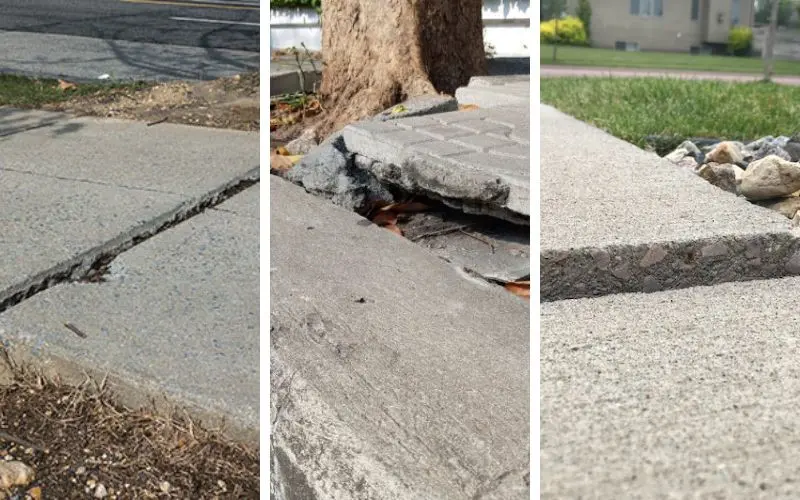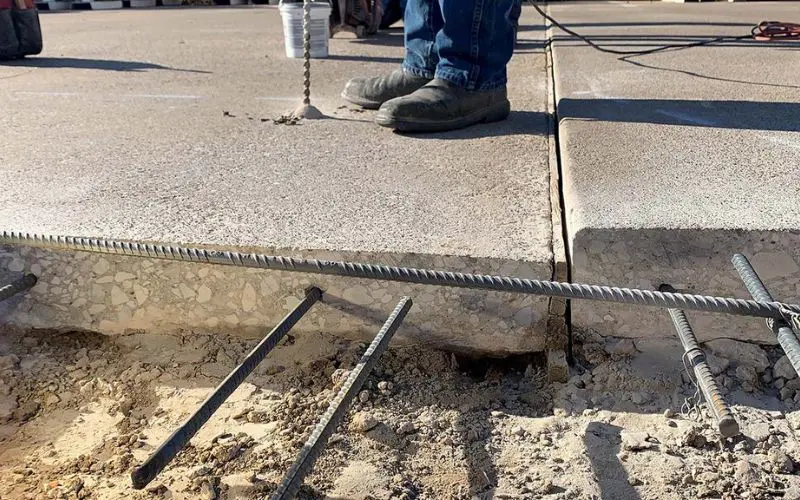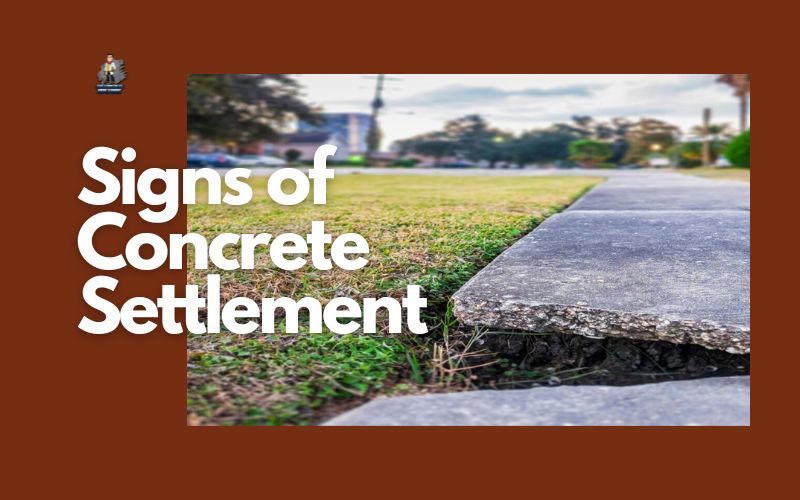Concrete settlement refers to the sinking or lowering of concrete slabs or foundations over time. This occurs as the soil underneath the concrete compacts and consolidates. Concrete naturally settles somewhat over time. A minor settlement usually does not significantly impact the home. However, an abnormal or excessive settlement demands attention. Being able to recognize the common signs of concrete settlement enables homeowners to address this issue promptly.
Addressing these signs quickly is key, and solutions like polyurethane concrete raising have become a popular choice for restoring sunken slabs efficiently. This method not only helps level the affected areas but also reinforces the stability of the structure.
Causes of Concrete Settlement

Understanding the signs of concrete damage is essential when addressing the causes of concrete settlement. Factors such as fluctuating moisture levels, poor soil compaction, and the natural breakdown of organic materials in the soil can all contribute to a shifting foundation. By recognizing early warning signs—like cracks, uneven surfaces, or gaps between slabs—you can take timely action to prevent further deterioration and stabilize the affected area.
Implementing effective foundation waterproofing measures can help prevent water-related soil erosion and maintain the stability of your concrete foundation. This proactive approach not only protects your home but also reduces the chances of costly repairs in the future.
Concrete settlement occurs when the soil underneath a concrete slab shifts or settles, causing the concrete to sink or drop.
- Soil settling and shifting: All soil settles over time as the weight above it compresses it down. If the soil was not properly compacted before the concrete slab was poured, it is more likely to settle unevenly, causing cracks and sinking spots in the concrete.
- This process of soil settling and shifting can have a significant impact on foundation stability. When the ground beneath a structure moves or becomes uneven, it can lead to structural imbalances that compromise the integrity of the foundation. Over time, these subtle shifts may result in visible damage, such as cracked walls or misaligned doors and windows, making early detection and intervention crucial.
- Erosion: Water erosion under the slab can wash away soil, causing voids that make the concrete sink. Improper drainage or leaky pipes can cause this kind of erosion over time.
- Tree roots: Tree roots growing under the concrete can sometimes lift or shift sections, causing uneven settlement. Large root systems can create voids as they decompose.
- Poor construction: Bad concrete mix, insufficient steel rebar reinforcement, or an inadequate base layer under the slab can lead to cracking and sinking when weight is applied.
- Freeze-Thaw Cycles: In cold climates, the soil under the slab can shift as it freezes and thaws repeatedly. This stresses and weakens the concrete over time.
Signs of Concrete Slab Settlement
Addressing settlement issues typically involves specialized techniques that stabilize and restore the slab. Among these solutions, concrete crack repair plays a vital role in minimizing further damage and maintaining the structural integrity of the slab.
Concrete slabs can show various signs of settlement issues. Here are some of the most typical indicators to look for:
- Cracks: One of the most obvious signs is cracking in the concrete slab. This includes large cracks extending across the slab as well as smaller hairline cracks. Cracks occur because the slab segments are shifting separately as the ground settles.
- Uneven surfaces: If areas of the concrete appear sunken or uneven, this points to settlement problems. You may notice some parts are higher than others, indicating the slab is no longer level. Using a level tool can help identify uneven spots.
- Gaps: Gaps can appear between the slab and walls, posts, or steps. This happens when the slab sinks while the surrounding structures remain stable. The gaps signal that the slab is pulling away from other elements.
- Doors or windows sticking: If doors and windows suddenly become difficult to open or close, it shows the walls and slab are out of alignment due to shifting. Settlement causes everything to fall out of the square.
- Cracked foundations or masonry: In addition to the slab itself, look for cracks in the foundation, brickwork, stucco, or other masonry elements. Settlement can fracture the materials as the ground sinks.
Careful Inspection of Concrete Surfaces
Carefully inspecting these signs can reveal underlying settlement issues before they worsen. The earlier settlement is detected, the easier and less expensive repairs tend to be.
Checking Doors and Windows
Doors and windows that suddenly become difficult to open or close can be a telltale sign of concrete slab settlement. As the foundation sinks, it can throw off the alignment of doors and windows, causing them to stick or rub against the door frame or window sill.
Check all exterior doors and windows to see if any are suddenly harder to operate. Pay attention to whether you need to lift the door or window to get it unstuck when opening or closing.
Use a ruler to measure any new gaps, as the width can indicate the extent of the settlement. Gaps wider than 1/8 inch typically signify a foundation problem. The gaps may be wider at the top or bottom, depending on the direction of settlement.
Inspecting Walls and Ceilings
Look for horizontal or vertical cracks, especially near doors and windows, as these can indicate foundation movement. In some cases, the shifting of the structure can lead to bowing or bulging walls, which may require reinforcing foundation wall solutions to maintain structural integrity. Regular inspections and timely repairs can prevent small issues from escalating into costly damage.
Concrete settlement can cause cracks, uneven surfaces, and other issues with walls and ceilings that are supported by the foundation. Carefully inspect all interior wall surfaces, corners, and ceilings for any signs of damage.
Look for vertical cracks in walls, especially near doors, windows, and corners. Settlement cracks often start at the top of walls near the ceiling and extend downward as the foundation sinks. The cracks may be thin hairline cracks or wider gaps. Tap along walls and listen for hollow sounds, which can indicate voids behind drywall.
Check the ceilings for sagging spots, cracks, or areas that appear uneven. Look for cracks around ceiling light fixtures and fans as well. Drywall tape coming loose along seams and nails or screws popping out are also signs of settlement.
Inspect textured ceilings closely for cracks forming through the texture. Subtle settlement cracks can be difficult to spot in textured ceilings sometimes. Shine a light at an angle along the ceiling to highlight any irregularities.
Checking Plumbing
One of the most apparent signs of concrete settlement is issues with plumbing in the home. As the foundation shifts, it can cause pipes to break, leak, or become misaligned. This leads to a variety of problems:
- Slow or clogged drains. If the piping has shifted, it can cause blockages and impede water flow. Drains will be slow to empty or may even get completely backed up.
- Leaking pipes. Concrete settlement can cause pipes to crack, rupture, or disconnect at joints. This leads to water leaks that may be obvious, like water dripping from the ceiling. But leaks can also be hidden in walls or under floors.
- Running toilets. If the toilet bowl or tank has shifted, it can create a small gap or misalignment that causes water to continuously run. The toilet won’t shut off properly.
- Dripping faucets. Like running toilets, faucet issues can indicate piping shifts. Faucets may drip persistently due to misalignments.
- Loss of water pressure. If a settlement has damaged piping, it can reduce water flow and decrease water pressure in the home.
Prevention Tips
Concrete settlement can often be prevented with proper site preparation and foundation design. Here are some tips:
- Ensure proper drainage around the foundation to prevent water from pooling. The soil should be graded to slope away from the house. Install gutters, downspouts, and extended drain pipes if needed.
- Compact and prepare the soil before pouring the foundation. Remove topsoil and fill low areas. The soil under the slab should be compacted to at least 95% of its maximum density.
- Install a vapour barrier under the slab. Plastic sheeting prevents moisture from evaporating up through the concrete.
- Size the foundation footings properly for the load-bearing weight. Footings that are too small can settle and cause cracking.
- Allow the concrete to cure fully before building on top of it. Concrete reaches full strength over several weeks. Avoid heavy construction traffic over fresh concrete.
- Get recommendations from an engineer for specific soil conditions, like expansive clay. Special foundation designs may be needed.
Taking steps during construction to prepare the soil and foundation properly will help prevent settlement issues down the road.
Professional Concrete Levelling and Repair Services in Edmonton

Looking for concrete levelling and repair in Edmonton to restore your sunken concrete surfaces? Look no further than The Concrete Doctors for reliable concrete mudjacking in Edmonton and Sherwood Park.
With over 25+ years in the concrete industry, we have the experience and expertise to efficiently repair and level your concrete surfaces using the latest mudjacking techniques. Contact us today for a free estimate and to see how we can help restore your concrete surfaces to their original condition.
Final Assessment
Identifying concrete settlement issues promptly is crucial for preventing further structural damage. Even minor settlements can progressively worsen over time if left unchecked. Cracks in walls, ceilings, and foundations will continue to expand, leading to more costly repairs down the road. Being aware of warning signs like sticking doors and windows, sloping floors, and exterior cracks enables early detection.

